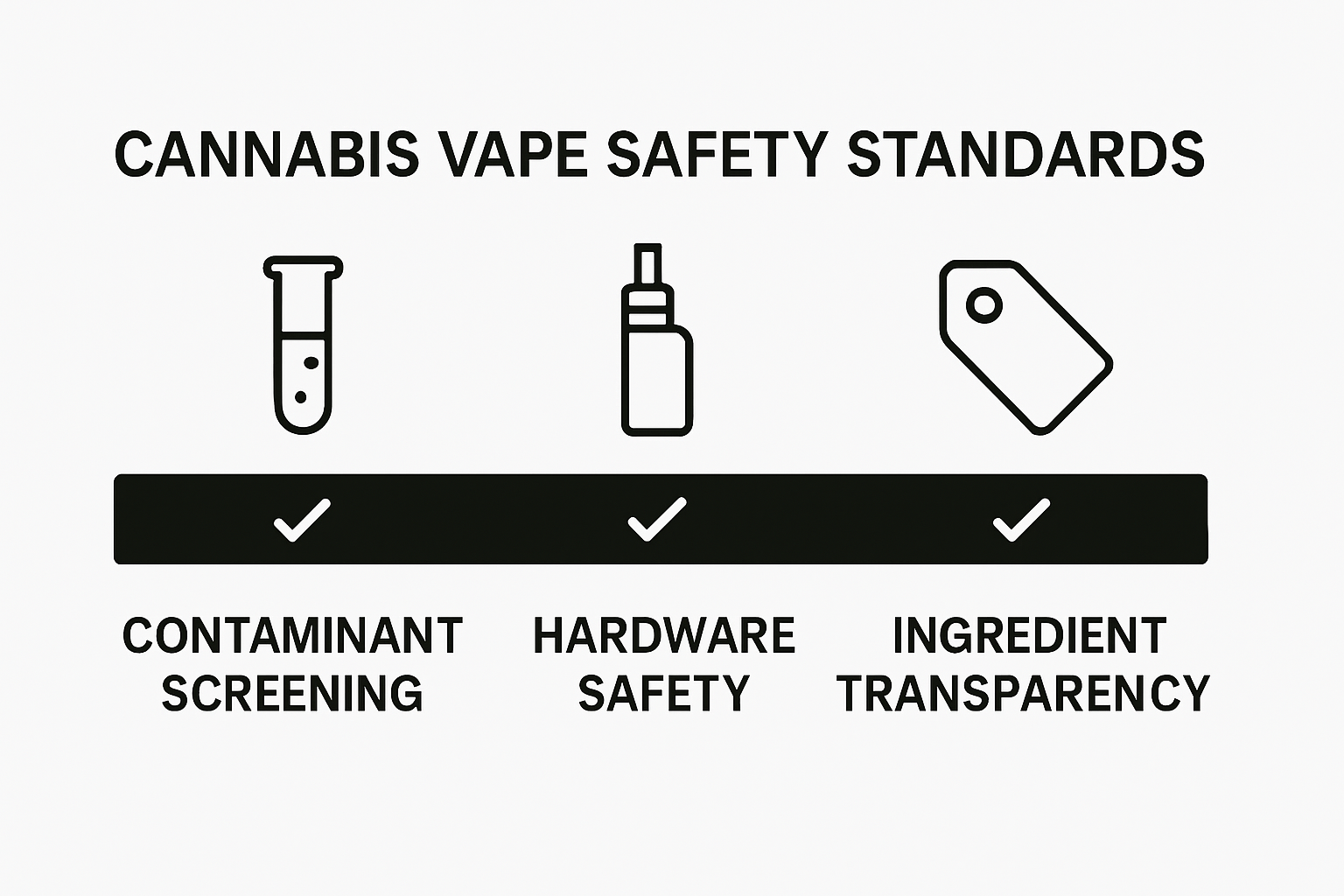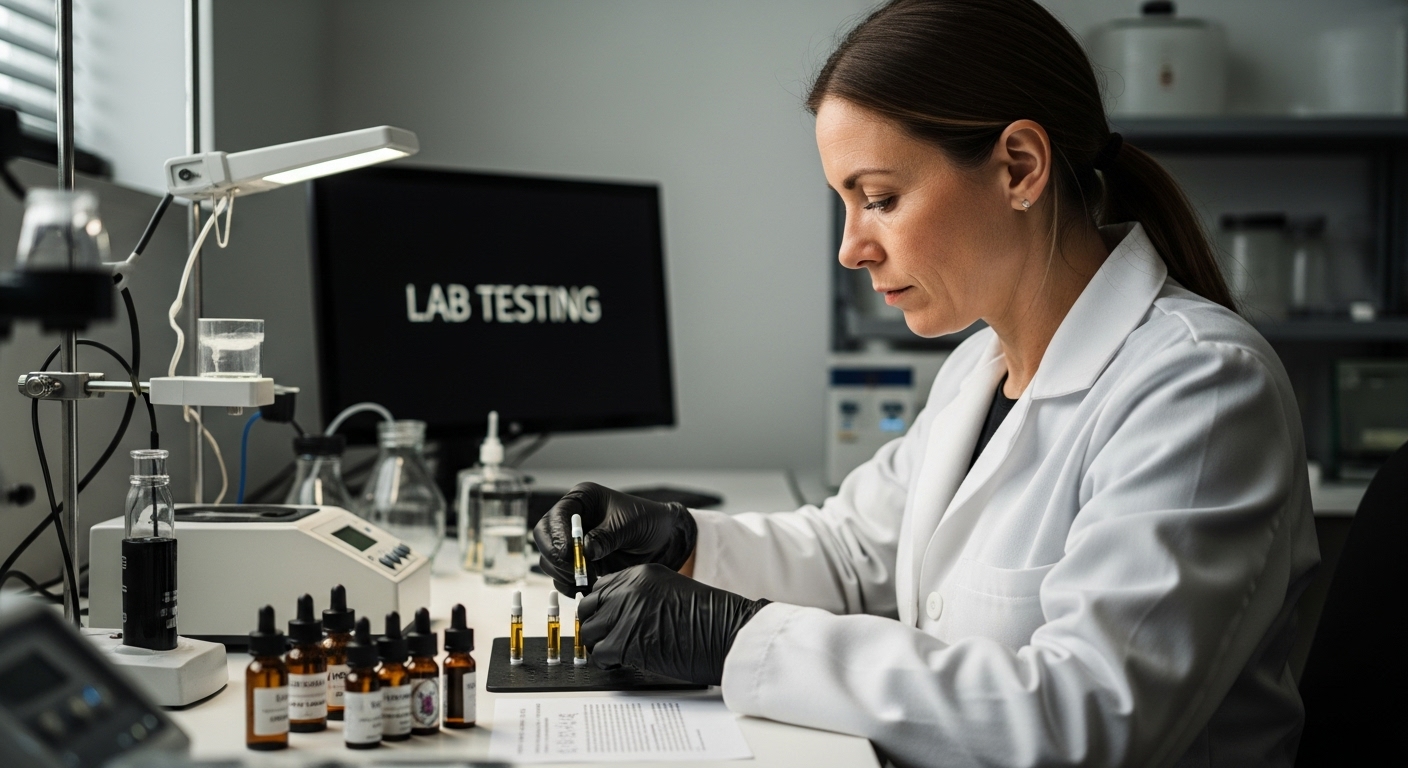Blog
Understanding Cannabis Vape Safety Standards for Users
Cannabis vapes promise a cleaner, smoother experience with each puff and have exploded in popularity, especially with younger adults. But while millions of people trust these sleek devices, the real story is hiding in the numbers. Research shows that unregulated vapes can contain dangerous contaminants that put your health at risk, including heavy metals and pesticides. This means the difference between a safe session and serious health issues depends on strict safety standards, not just fancy packaging.
Table of Contents
- What Are Cannabis Vape Safety Standards?
- Why Cannabis Vape Safety Standards Matter
- How Cannabis Vaping Products Are Regulated
- Key Components Of Safe Cannabis Vape Products
- Real-World Impacts Of Cannabis Vape Safety Standards
Quick Summary
| Takeaway | Explanation |
|---|---|
| Cannabis vape safety standards protect consumers. | These standards ensure the quality and reliability of vape products, mitigating health risks associated with contaminants. |
| Rigorous testing is essential for product safety. | Extensive testing for pesticides, heavy metals, and microbial contamination is crucial to safeguard consumer health before products reach the market. |
| Transparency in ingredient labeling builds trust. | Clear communication about product contents fosters consumer confidence and supports informed purchasing decisions in the cannabis vaping market. |
| Compliance with regulations enhances product consistency. | Adhering to established safety protocols ensures uniform product quality, reducing variations and potential health hazards for consumers. |
| High-quality materials improve vape product safety. | Utilizing medical-grade components and non-toxic materials minimizes harmful chemical interactions during the vaping process, promoting consumer safety. |
What Are Cannabis Vape Safety Standards?
Cannabis vape safety standards represent a comprehensive framework designed to protect consumers and ensure the quality, purity, and reliability of cannabis vaporization products. These standards encompass multiple critical aspects of product development, manufacturing, testing, and distribution.
Defining Safety Standards in Cannabis Vaping
Safety standards for cannabis vapes are multifaceted protocols that address potential risks associated with cannabis concentrate consumption. According to the National Vaping Institute for Health and Safety, these standards typically focus on several key areas:
- Chemical composition and purity analysis
- Manufacturing quality control
- Contaminant screening
- Hardware safety specifications
- Ingredient transparency
The primary goal of these standards is to mitigate potential health risks and ensure consumers receive a consistent, safe product.
 This involves rigorous testing for harmful substances like pesticides, heavy metals, residual solvents, and microbial contaminants that could pose significant health hazards.
This involves rigorous testing for harmful substances like pesticides, heavy metals, residual solvents, and microbial contaminants that could pose significant health hazards.
Regulatory Frameworks and Compliance
Regulatory bodies are increasingly developing comprehensive guidelines to standardize cannabis vape production. These frameworks require manufacturers to adhere to strict protocols that verify product safety before market distribution. The CDC’s National Institute for Occupational Safety and Health (NIOSH) emphasizes the importance of comprehensive safety evaluations that consider various potential exposure risks.
Key compliance areas include:
- Precise THC and CBD concentration measurements
- Comprehensive laboratory testing protocols
- Packaging and labeling requirements
- Age verification mechanisms
For consumers interested in understanding more about product verification, read more about our guide on lab testing essentials, which provides deeper insights into ensuring product quality and safety.
Ultimately, cannabis vape safety standards represent an evolving framework designed to protect consumer health, promote transparency, and establish trust within the rapidly developing cannabis concentrate market.
Why Cannabis Vape Safety Standards Matter
Cannabis vape safety standards are critical for protecting consumer health, ensuring product quality, and maintaining industry integrity. These standards go beyond simple regulatory compliance and represent a fundamental commitment to user safety and responsible product development.
Health Protection and Risk Mitigation
Safety standards play a crucial role in minimizing potential health risks associated with cannabis vaping. According to research published in the Journal of Cannabis Research, unregulated cannabis vape products can contain dangerous contaminants that pose significant health hazards:
- Potential exposure to harmful pesticides
- Presence of residual solvents
- Risk of heavy metal contamination
- Inconsistent cannabinoid concentration
- Potential microbial contamination
By establishing rigorous testing and quality control protocols, safety standards help eliminate these risks and protect consumers from potential long-term health complications.
Consumer Trust and Industry Credibility
Comprehensive safety standards are essential for building consumer confidence in the cannabis vaping market. These frameworks demonstrate a commitment to transparency, quality, and responsible manufacturing. For consumers interested in understanding product verification processes, our guide on lab testing provides deeper insights into ensuring product reliability.
Key benefits of robust safety standards include:
- Enhanced product consistency
- Clear communication of product ingredients
- Standardized manufacturing processes
- Reduced health risks for consumers
- Improved industry reputation
Ultimately, cannabis vape safety standards represent a critical mechanism for protecting consumer health, promoting responsible industry practices, and establishing a foundation of trust in an evolving market landscape.
How Cannabis Vaping Products Are Regulated
Regulation of cannabis vaping products represents a complex and evolving landscape involving multiple governmental and industry stakeholders. These regulatory mechanisms aim to protect consumer safety, ensure product quality, and establish standardized guidelines for manufacturing and distribution.
Federal and State Level Regulatory Approaches
According to the CDC’s comprehensive regulatory analysis, cannabis vaping product regulation operates through intricate multilayered frameworks that differ significantly across jurisdictions. Key regulatory bodies involved include:
- State cannabis control boards
- Public health departments
- Food and drug administration agencies
- State agricultural departments
- Local licensing authorities
Each jurisdiction implements unique requirements for product testing, packaging, labeling, and distribution, creating a nuanced regulatory environment that demands manufacturers maintain rigorous compliance standards.
To help clarify the complex regulatory environment, the following table compares key aspects of federal and state-level approaches to cannabis vape product regulation.
| Regulatory Level | Key Regulatory Bodies | Main Focus Areas | Unique Challenges |
|---|---|---|---|
| Federal | Food and Drug Administration (FDA), CDC | Workplace safety, public health guidance | Inconsistent national standards |
| State | State cannabis boards, state health depts. | Product testing, packaging, labeling, licensing, distribution | Varying requirements across jurisdictions |
| Local | Local licensing authorities | Retail licensing, zoning, enforcement | Coordination with state/federal regulations |
Comprehensive Testing and Compliance Requirements
Regulatory frameworks mandate extensive product testing to verify safety and quality. These protocols typically require comprehensive screening for potential contaminants, accurate cannabinoid concentration measurements, and verification of product integrity. For consumers interested in understanding more about product specifications, our guide provides insights into disposable cannabis vape technologies.
Critical compliance areas include:
- Precise THC and CBD concentration verification
- Screening for pesticides and heavy metals
- Microbial contamination testing
- Residual solvent analysis
- Packaging and labeling accuracy
These stringent regulatory measures ensure that cannabis vaping products meet established safety standards, protecting consumer health and promoting industry transparency.

Key Components of Safe Cannabis Vape Products
Safe cannabis vape products are defined by sophisticated design elements and rigorous quality control mechanisms that prioritize user health and product reliability. Understanding these critical components helps consumers make informed decisions about their cannabis vaping experience.
Hardware and Material Quality
According to the CDC’s comprehensive safety guidelines, the foundational safety of cannabis vape products begins with high-quality hardware and material selection. Essential hardware considerations include:
- Medical-grade stainless steel components
- Ceramic heating elements
- Non-toxic battery materials
- Leak-resistant cartridge designs
- Temperature-controlled heating mechanisms
These design elements minimize potential chemical interactions and reduce the risk of harmful substance generation during the vaporization process.
The table below summarizes the essential components that define safe cannabis vape products by highlighting their features and safety benefits.
| Component | Safety Feature | Benefit to Consumer |
|---|---|---|
| Medical-grade stainless steel | Resists corrosion, minimizes leaching | Reduces contamination risk |
| Ceramic heating elements | No metal exposure, stable heating | Delivers cleaner vapor |
| Non-toxic battery materials | Prevents harmful emissions | Maintains air quality and safety |
| Leak-resistant cartridge design | Prevents leakage of oil | Reduces accidental exposure |
| Temperature-controlled mechanisms | Avoids overheating and toxin formation | Ensures product reliability and purity |
| Zero vitamin E acetate | Eliminates harmful additive | Lowers risk of lung injury |
| Comprehensive contaminant testing | Screens for pesticides, metals, solvents, microbes | Protects against hidden health hazards |
Chemical Composition and Purity Standards
The chemical profile of cannabis vape products represents a critical safety determinant. Pure, carefully processed concentrates free from contaminants are fundamental to user safety. For users interested in understanding product storage and preservation, our guide offers insights into maintaining product integrity.
Key purity requirements include:
- Zero presence of vitamin E acetate
- Absence of residual solvents
- Verified cannabinoid concentration
- Comprehensive pesticide screening
- Elimination of heavy metal contamination
Comprehensive testing and stringent quality control protocols ensure that cannabis vape products meet the highest safety standards, protecting consumers from potential health risks associated with impure or poorly manufactured concentrates.
Real-World Impacts of Cannabis Vape Safety Standards
Cannabis vape safety standards have transformed the industry landscape, creating tangible improvements in consumer protection, product quality, and public health outcomes. These standards represent more than theoretical guidelines they produce measurable real-world benefits that directly impact user experiences and industry practices.
Public Health Protection
According to the CDC’s comprehensive investigation of vaping-related health incidents, safety standards have been crucial in mitigating significant health risks. The implementation of rigorous testing and quality control mechanisms has resulted in substantial public health improvements:
- Dramatic reduction in lung injury cases
- Elimination of dangerous additive substances
- Enhanced transparency in product composition
- Decreased contamination risks
- Improved consumer confidence
These standards have effectively reduced the potential for serious health complications associated with unregulated cannabis vaping products.
Consumer Education and Market Transformation
Safety standards have fundamentally reshaped consumer expectations and industry practices. For users interested in understanding product variations, our guide explores different vaping technologies, highlighting the ongoing evolution of cannabis vaping products.
Key market transformations include:
- Increased manufacturer accountability
- More sophisticated product development
- Standardized testing protocols
- Enhanced consumer awareness
- Reduced prevalence of substandard products
Ultimately, cannabis vape safety standards represent a critical mechanism for protecting consumer health, promoting responsible industry practices, and establishing a foundation of trust in a rapidly evolving market landscape.
Invest in Verified Safety with Shorties Disposable Vape
Are you worried about the hidden risks of cannabis vaping—like unsafe hardware, hidden contaminants, or unverified ingredients? The article highlights how up-to-date safety standards and transparent lab testing are crucial for your health and peace of mind. At Shorties Disposable, we respond to these concerns with action. Our products come with clearly listed lab results and ingredient transparency, letting you make informed, confident decisions every time you shop.

Take control of your vaping experience today. Visit Shorties Disposable Vape for premium, lab-tested vape devices that meet rigorous quality standards. Explore our live-resin vape product lineup and discover more ways to spot safe, authentic cannabis products in our educational resources. Secure your health and satisfaction—choose Shorties now and feel the difference.
Frequently Asked Questions
What are cannabis vape safety standards?
Cannabis vape safety standards are comprehensive guidelines designed to protect consumers by ensuring the quality, purity, and safety of cannabis vaporization products. They focus on areas such as chemical composition, manufacturing quality, contaminant screening, and hardware safety.
Why are safety standards important for cannabis vaping?
Safety standards are essential for minimizing health risks associated with cannabis vaping, such as exposure to harmful contaminants. They also foster consumer trust by demonstrating a commitment to quality and transparency in the cannabis market.
How are cannabis vaping products regulated?
Cannabis vaping products are regulated through various frameworks established by governmental and industry stakeholders. These regulations include requirements for testing, packaging, labeling, and distribution, varying by jurisdiction but emphasizing safety and quality compliance.
What aspects of cannabis vape products should consumers be aware of?
Consumers should pay attention to the quality of hardware materials, chemical composition, and purity standards of vape products. Key considerations include the absence of harmful additives, accurate cannabinoid concentrations, and rigorous testing for contaminants like pesticides and heavy metals.
Recommended
- 8 Essential Tips for Your Lab Testing Checklist – SHORTIES DISPOSABLE VAPE
- Understanding Safe Vape Storage: Protecting Your Products – SHORTIES DISPOSABLE VAPE
- Understanding What Are Disposable Cannabis Vapes – SHORTIES DISPOSABLE VAPE
- Understanding the Role of Lab Testing in Cannabis – SHORTIES DISPOSABLE VAPE

